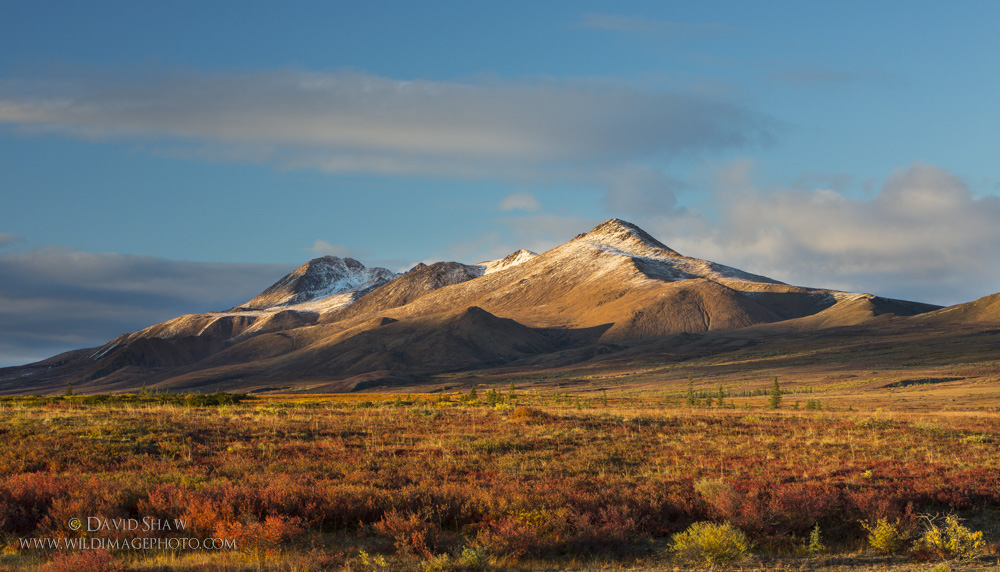It was August 30. Though that is still summer in much of the country, in northern Alaska, autumn was in full swing. I was guiding my final trip of the season, a week-long canoe trip down the Kelly River. The Kelly is a short, heavily braided tributary to the lower Noatak. It doesn’t see a lot of traffic, and it is one of the most beautiful places I’ve ever seen. The mountains are almost bare of vegetation, strangely, considering the rich tundra, and patches of spruce forest in the valley floor. Yet the contrast in the landscape is appealing, and makes the mountains seem even more wild and intimidating.
The morning I made this image I woke up to three inches of fresh, wet and heavy snow. The river flowed in a dark line between gravel bars coated in white. It was beautiful, and cold, and for a guide, a bit nerve-wracking. I fired up the stove, in our group’s large cook tent and started the morning coffee. Slowly the clients began to emerge from their tents. This group was an extended family of parents, kids, siblings and significant others. Almost half the group was young in comparison to the majority of my clients on wilderness trips. Which is to say, they were under 40.
By the time the first of the clients stepped into the kitchen tent, the frost was dripping from the ceiling, cowboy coffee was brewing and it was downright warm. Despite the night’s snow, most of them had slept surprisingly well, the layer of snow on the tents providing an extra layer of insulation. By the time I was flipping pancakes, the rest of the group was up and the tent was full of morning chatter.
Outside, the breeze had picked up a touch and was beginning to tear the scudding clouds apart. Patches of blue appeared and disappeared, but it was unquestionably clearing. After breakfast we lit a small fire, and watched the weather shift over the next hour from clouds and snow squalls to broken overcast, and on to immaculate blue.
We spent the early afternoon hiking on a fruitless fishing trip to a nearby lake (through the snow-covered tundra) and watching the sun slowly turn that snow back to water. We ate dinner outside in the sun, the snow then almost gone from the landscape.
That evening, the “youngsters” and I headed out to the tundra about a mile from camp. The day before, our group had seen a bear and three different wolves nearby and we were hoping for a little wildlife watching.
We arrived an hour before sunset, broke out the Crazy Creek chairs and thermoses of tea and settled in. A half hour later when the sun was getting close to the mountains on the far side of the valley, I leaned back in my chair, pointed my camera north, and snapped this shot without so much as standing up.
Now you might think that all this back story is unnecessary, but I’ve included it for a reason. The emotions of the day, the nerves from the storm, the relief at the sun, and the celebration surrounding the sublime evening all led to this image. I made dozens of shots of that lovely fall tundra, freshly cleared of snow; far more than I would have had it been another day. Also, the warmth of the sun, the company of the people, and not wanting to spook any unseen wildlife, kept me from wandering to create a more thoughtful composition.
In short, the events of a day, any day, lead to the images we make. Sure, I probably could have found a better image if I’d gotten up and wandered around, but this image reminds not just of the landscape, but also the people I was with, my relief at the change in the weather, and the tear-jerking beauty of that evening. Sometimes it’s just as good to make an image because of what it means to you, not just to the others who may see it.
Related posts:
After 17 days of canoeing, hiking, photography, rain and wind dodging, ...
A Black-browed Albatross glides over the churning waters of the South Atl...
Canon 5D iii, Canon 24-105 f4L IS, ISO 400, f8.0, 105mm, 1/640th sec, han...

